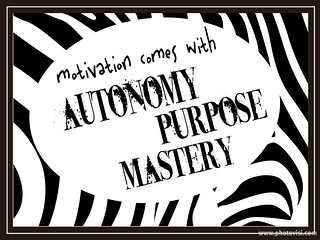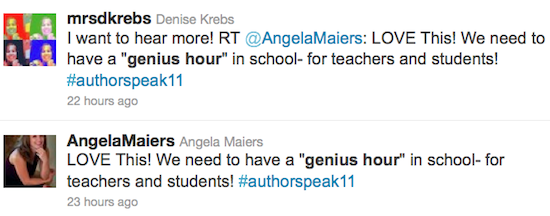The learners in my class of 2017 are geniuses. For over a year now, these students have had a chance to shape the agenda of their learning, at least part of the time. Because of genius hour, my students are learning to care again about learning. They choose what they will learn based on what they wonder about, what they are good at, and what they are passionate about.
It was a little over a year ago when I read a tweet by Angela Maiers about Daniel Pink‘s keynote address about motivation. I had seen the video “The Puzzle of Motivation“, and I had read his books A Whole New Mind and Drive. I had yet to fully translate the work to my students.
I had an epiphany after I read Angela’s tweet and later this blog post by Daniel Pink, “Genius Hour: How 60 minutes a week can electrify your job.” I knew that according to Pink, we are motivated with autonomy, purpose, and mastery. If we want motivated students, why not let students become motivated by giving them autonomy to master what they wish for their purpose? It makes sense! Why NOT, indeed?
purpose, and mastery. If we want motivated students, why not let students become motivated by giving them autonomy to master what they wish for their purpose? It makes sense! Why NOT, indeed?
So, our first genius “hour” was a three-hour block of time on the Wednesday morning before (American) Thanksgiving in 2011. It was such a thrill to watch the students fully engaged in purposeful learning, creating, producing, and mastering. They chose what they wanted to work on.
We have continued to find our way through genius hour learning over the past 15 months. People often ask me if the students have trouble staying on task. To those people I say a resounding, “No, they do not have trouble staying on task.” (However, as most teachers can attest, they sometimes do when we aren’t in genius hour, when I am dictating the agenda.)
Skeptics and future genius hour teachers alike also ask, “Do students take advantage of the freedom?” “Yes, fully!” I say with enthusiasm. They love the learning environment during genius hour. They use every moment wisely. In fact, one of my favorite things during our first genius hour morning was when the bell rang after the first period. (The bells continued to ring because our high school students were in regular classes that morning.) Initially when we heard the bell, I saw the look of disappointment on their faces. Then a look of sunshine and delighted cries of “Ooh, we don’t have to leave!” (Chances are good that most of us don’t normally hear that kind of reaction at the end of a first period class.) All morning students continued to learn, ignoring bells, only taking an occasional bathroom break.
Now, to be sure, I know what people REALLY mean when they ask, “Do they take ‘advantage’ of the freedom?” They mean, “Do students screw around, instead of learning on their own?” To that I answer absolutely NOT. They have purpose. They have chosen what they want to learn; no one dictated it. They are given freedom to take as long as is needed to be satisfied with their learning.
Now that we have genius hour each week for two periods (20% of our time together), I have students for whom that is not enough. They work on their genius hour projects during study halls, before school, at home, and during recesses. They are passionate because they have chosen purposeful learning.
However, there is one negative that has cropped up over this past year, which I am just starting to figure out. In about 10-20% of students, their actions seem to say, “Too much freedom; just tell me what to do.” They don’t screw around really, but they don’t seem able to take hold of the learning for themselves. Typically I see these few trying to partner up with other students who have an idea. Then the more reluctant one acts as a helper of sorts for the other student’s learning. They sometimes want to switch alliances as they lose interest in their first partner or group. They are not fully engaged. (As opposed to what also happens — two or three students with the same passion join forces for a group project.)
In an attempt to alleviate the problem of the 2 or 3 students in a class who struggle finding their genius, I’ve been asking them to reflect upon these three prompts.

I keep working with them until they are willing and able to list their 30 “genius” ideas. (It is especially hard for some of them to admit to ten things they are good at). The lists become great conversation starters about what a learner might do for genius hour.
Sir Ken Robinson explains in The Element that when someone doesn’t know how to read and write, we don’t assume they are incapable of literacy. Instead we know that they haven’t yet learned how to read and write. In a similar manner, he explains, when someone isn’t creative, we should not assume that they are incapable of creativity. We should assume they just need to be taught.
I am trying to teach my students how to be creative.
The next graphic shows the Universal Constructs from the Iowa Core. These building blocks for success in the 21st century align perfectly with genius hour learning. I have had one-on-one conferences with my less creative students, showing them these “building blocks for success” and holding them accountable for the work they do during genius hour. Sometimes it means having a learner write an analysis of why he chose to abandon an idea. Or helping another learner find a way to be flexible and adapt instead of abandoning her idea. I have listened to struggling small groups (limited to 2-3 people per group) as they figure out how to collaborate more effectively.
Next up in my what-I-learned series is to make a video to show genius hour from my students’ perspective. For now, though, I will share a video created by Gallit Zvi, another genius hour leader. It shows great work by her geniuses. I used it to introduce genius hour to my new class this year.
More Resources:
- Genius Hour wiki
- Genius Hour Blog Post Index – A list of posts from my genius hour beginnings and links to other teachers’ work.
- Center for Digital Education’s “Google’s 80/20 Principle Applies to Students“
- Education is My Life – “Designing 20% Time in Education“
- 2/15/13 – I did finish my latest “What is Genius Hour?” video.
- #geniushour Twitter Chat on the first Thursday of the month at 9:00 p.m. EST
- 3/18/13 – A comprehensive Genius Hour Livebinder by Joy Kirr.
All images are shared with a CC Attribution license. You are free to use them, just click on image for more info.



